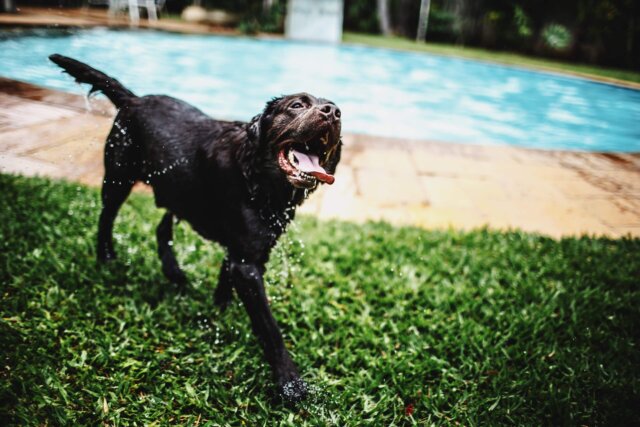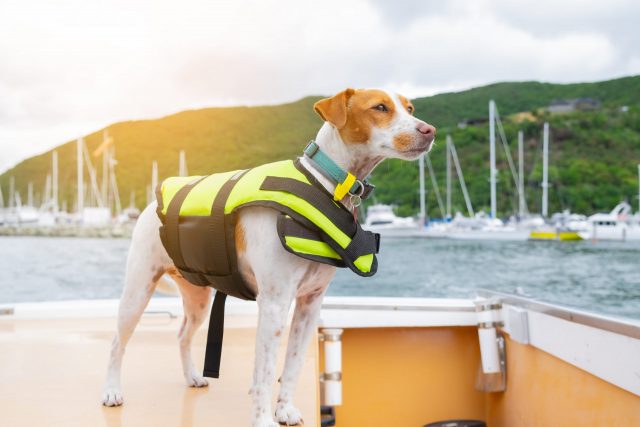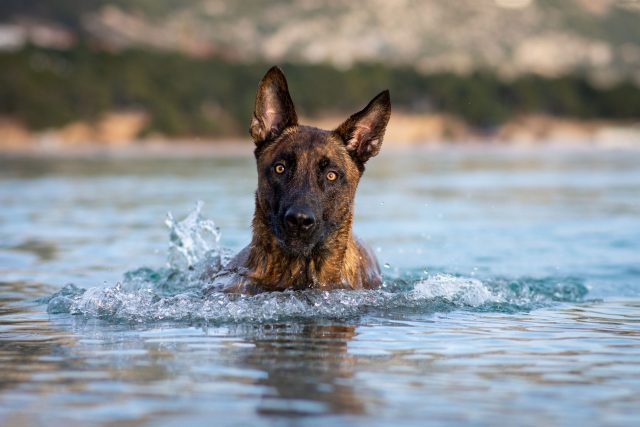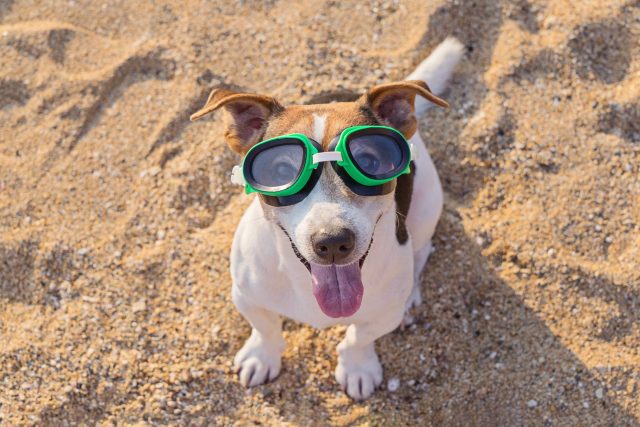As the weather warms up and you head for the nearest body of water (pool, lake, creek, ocean, etc), make sure your dog’s fun doesn’t end in tragedy by following these expert water safety tips.
Dr. Denise Petryk, Trupanion’s director of veterinary services, shares this list of top safety tips to help pet owners keep their dogs safe by the pool or on the open water:
- Watch: Know where your pets are and what they’re doing.
- Pool Safety: Pets must be able to get out easily.
- Wash: Don’t let salt or pool chemicals dry in your dog’s fur.
- Life Jackets: The right fit, buoyancy, handles and bright colors so you can easily spot your pet are all vital.
- Rest: Swimming can be strenuous! Give your pet plenty of breaks and clean drinking water.
- Water: Don’t let your dog lap up lake, river, pool or ocean water.

While this is a great start, let’s explore some of the other water-related dangers your dog may encounter this summer.
Dirty Water
Water can be full of bacteria, pollutants and even certain algae that are harmful for dogs. If you wouldn’t go in the water, don’t let your dog. You can carry water test kits with you that test for certain things, but it’s best to just do your research and find areas that are known to be “clean water” areas.
Related: 10 Best Underground Dog Fences
Sun Exposure
Kimberly Brenowitz is a master dog trainer, and owner of Animal Deserves Better Training in Georgia. She reminds us that swimming often involves excessive sun exposure, which can cause heat problems for animals, just like humans.
Watch your dog for the following signs of overheating:
- Excessive panting
- Disorientation
- Fast, noisy breathing
- Collapsing or convulsions
- Bright red or blue gums
- Vomiting
- Diarrhea
Hypothermia
Even if it’s 100 degrees outside, mountain lakes and creeks can be freezing cold, which can cause hypothermia, especially in young or senior dogs. Watch for:
- Lethargy
- Shivering
- Decreased Heart Rate
- Dilated Pupils
- Cold extremities (tail, tips of the ears, scrotum and foot pads)
- Unconsciousness
Electrocution + Drowning
Elizabeth Avery is the founder of a travel agency specializing in single-person trips. She has spent a lot of time traveling with her seven dogs. She frequently takes her sheepdog sailing. She noticed that even though her dog did not like water, he would still try to jump in after her if she left the boat at the dock.
“Since dogs tend to follow their owners everywhere and are likely to miss the pier, this is a real danger,” she explains, “made worse in the harbor where there are electrical connections that could electrocute a dog that goes overboard.”
If you are leaving your boat, whether at the dock or to swim while boating, be sure your dog is secured in some way so he cannot jump off the boat on his own. Putting him in a kennel or below deck is the safest way to do this.
This will also help prevent accidental drowning – if your dog jumps overboard and panics while you are not around or can’t get to shore, he may drown before you even realize he has gone.
Your dog should always have his life vest on while on the boat, kayak, raft, etc. – even when he is not in the water.
 Sharks
Sharks
For those of you who venture into the ocean, sharks are becoming a more frequent sight along coastlines everywhere. Sharks have been seen in freshwater, too, especially the Bull Shark, which has the ability to survive in freshwater. They have even been spotted thousands of miles up the Mississippi River in Lake Michigan!
Veronica Grey, recipient of the 2015 Special Humanitarian Award, director of Worst Shark Attack Ever, avid surfer, and inventor of the world’s first and only line of shark repellent swimwear and surfboards, has a few tips for people when it comes to keeping your dog from beginning a shark snack.
“People think that what attracts sharks most is the smell of blood in the water,” says Grey. “While sharks are super sensitive to blood and can smell just one drop in an Olympic sized swimming pool, it isn’t what makes you need a bigger boat. The number one thing that attracts sharks is erratic splashing about in the water – it is, after all, the signature maneuver of a dying, flopping fish.”
“Unfortunately,” she continues, “your pet’s best efforts at doggie paddling in the ocean sends out the electrical vibration through the water exactly mimicking a splashing, flopping prey, possibly attracting an otherwise uninterested shark from hundreds of yards away.”
“Under NO circumstances should you EVER allow your beloved animal to swim ANYWHERE sharks are known to frequent, no matter how shallow – as there are dozens and dozens of unprovoked shark attacks that occur in less than two feet of water,” Grey advises.
Folks in regions where alligators are common should also take extreme caution when allowing their dogs to swim in marshes, lakes, and rivers.
Canine Life Jackets Are A Must
Before entering the water, make sure your dog is properly equipped to do so. This includes a doggy life vest. These are especially important for breeds like bulldogs and basset hounds, that are dense and top heavy with big chests. This combination makes it harder for them to stay afloat, which means they are working more than the average dog and will tire more quickly than say a Lab would.
“In order for a canine life jacket to work properly, the fit is critical. When choosing a life jacket, you want to look for an ergonomic cut that works with your dog’s particular body type,” says Denise Mange, a dog trainer in New York City.
So, how can you tell if the life jacket fits your dog well?
“A good litmus test of the cut of the jacket is whether your pup can comfortably walk while wearing the jacket on land,” says Mange. “If the jacket seems to be limiting his range of motion around the shoulders, odds are it will make swimming difficult as well.”
- There should be no more than the width of two fingers between his body and the vet.
- He shouldn’t be able to slip out of it while swimming
- He shouldn’t slip out of it if you have to lift him by it to assist him out of the water.
As for the type of life jacket to look for, here are Mange’s recommendations on what to look for:
“A flotation strap around his chest and under his belly. This additional buoyancy will help keep your pup afloat in a comfortable horizontal position (keeping his head above water), and also allow him to conserve energy while swimming in the water, so your dog can expend less energy trying to keep his head above water and more energy staying warm.”
“A sturdy handle that runs parallel to your pup’s spine between his shoulder blades is a critical feature to look for in a life jacket in case you have to pull your pup out of the water. A sturdy, well-placed handle will ensure your pup’s head is the first thing to come out of the water, and he will be lifted by the most sturdy part of his body- his ribcage. Again, lifting your pup while he’s wearing his life jacket on land not only serves as a good litmus test for the sturdiness and placement of the handle but is also a great way to desensitize your pup to the experience before you lift him by his life jacket out of the water.”
Additional features to seek in a canine life jacket:
- Does it release easily in the event it gets caught or tangled (in a branch for example)?
- Bright colors so you can see your dog (reflective strips are even better!)
Other Useful Gear
Denise Mange also recommends the following accessories to help you and your dog have more fun this summer:
Doggy Backpack
A doggy backpack allows your pup to carry his own water bowl, snack, etc.
Booties
We often think of these as a just a winter necessity, but Mange says they can help protect your dog’s paws from hot cement, sand, sharp rocks, and even the floor of your boat. How do you know the ground is too hot?
“A good test is to put the back of your hand against the sand for 5 seconds,” Mange says. “If it is too hot for your hand, your pup shouldn’t be walking on it.”
Water & Travel Bowl
Be sure your dog is hydrated and drinking clean water, as Dr. Petryk lists above. (Remember, open water is not necessarily clean!) Be smart and start by packing your own.
Forgot a bowl? No worries, Mange says a clean doggy bag can work as a water vessel in a pinch!



 Toledo, United States.
Toledo, United States.
